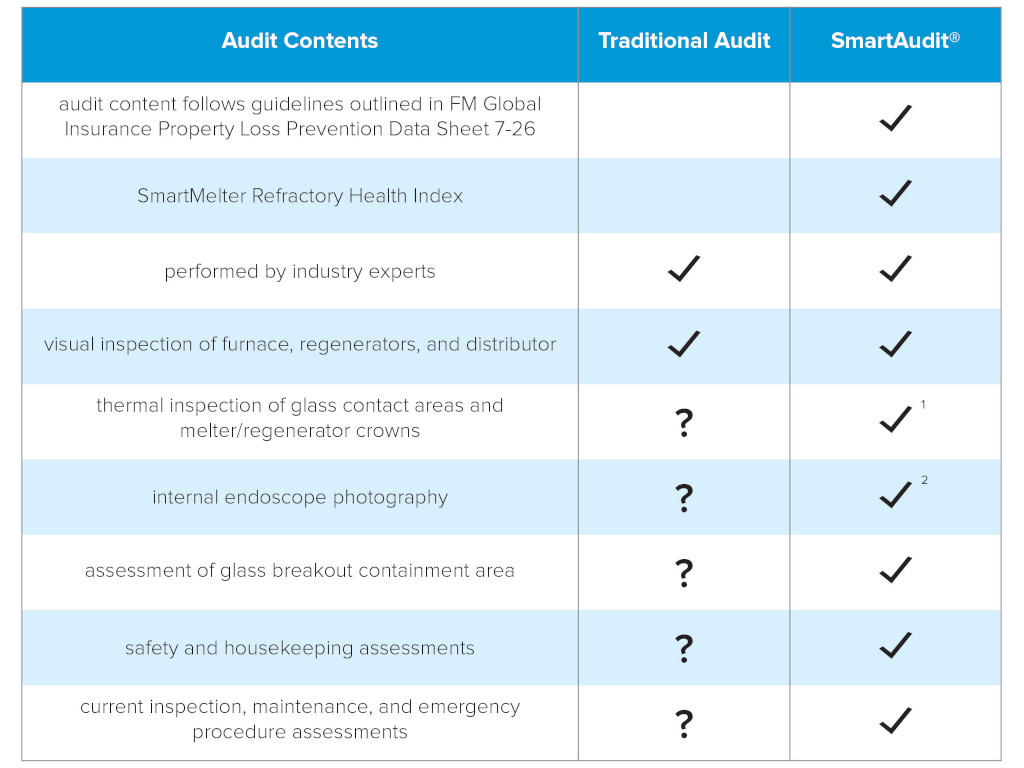Once a furnace is constructed, manufacturers use regularly scheduled inspections to monitor the condition of the refractory structure over its campaign life. Furnace audits are essential to identify issues early and prioritise maintenance expenditures. If the assessment is accurate, it helps the manufacturer to address potential problems before they become larger structural issues, extending the total life of the furnace.
A traditional furnace audit usually consists of a visual examination of the structure, thermographic inspection, and endoscopy. While these audits supply valuable information, they fall short of a comprehensive evaluation. The human eye and temperature assessment supply limited information and do not give a data-driven assessment of how the refractory is responding to furnace operations. Because there is no real assessment of how the current conditions are affecting the refractory wear, there is no opportunity to improve these conditions and optimise the campaign life.
More comprehensive report
PaneraTech is disrupting the traditional audit and introducing a more comprehensive report with a new service called SmartAudit. This advanced audit combines the latest technologies in furnace refractory inspection with highly experienced auditors in furnace refractory inspection to produce a data-driven refractory assessment. A SmartAudit includes traditional examinations such as visual inspection, endoscopy and thermography; however, it also incorporates SmartMelter radar and data from hundreds of radar inspections. The addition of radar to the audit means that manufacturers can make data-driven decisions about furnace operation, maintenance, and repair on an annual basis.
The SmartAudit radar component includes two measurements on each side of the furnace (eight total) to understand the general refractory condition of the metal line as well as up to 10 insulation measurements that can be completed on any sidewall or bottom insulation areas that are of a customer concern.
Refractory Health Index
A key component of SmartAudit is the SmartMelter Refractory Health Index, which measures how well a glass contact refractory is performing given its furnace age, operation and campaign history. This index leverages the SmartMelter database of over one million measurements at over 200 glass plants, along with operational data to determine what the expected current wear should be. PaneraTech can make appropriate recommendations for the furnace in the final audit report based on this data.
SmartAudit follows guidelines outlined in FM Global Insurance Property Loss Prevention Data Sheets. These data sheets are based on the research FM Global conducts to support their customers’ loss prevention efforts and are used as a risk management standard by multiple industries. Data sheet 7-26 outlines recommendations for glass manufacturing.
The data sheet directs glass manufacturers to implement an asset integrity program and provides a list of “maintenance, operating, and remaining life assessment activities” to be included “at minimum” in this program (Section 2.5.13). Among this list, FM Global asks glass manufacturers to “consider employing emerging technologies to help assess refractory health.” The data sheet continues by noting that “Radar-based technologies have been employed successfully for several years to monitor for thinning and/or glass penetration.” Finally, it recommends that manufacturers consider these technologies when planning to rebuild: If utilised, modify refractory support (steel) during the following rebuild to allow for a complete examination of furnace refractory.” (Section 2.5.13 D).
Experienced auditors
SmartAudit is not only about advanced technology; it also includes a standard of expertise for the auditor. PaneraTech has a strict list of qualifications for those who perform audits. Auditors must have at least 10 years of experience in the glass industry plus inspection experience as a third party or at the plant or corporate level, including visual inspection, thermography, and SmartMelter radar. The auditor is required to have experience with both cold and hot audits and extensive knowledge of furnace operations. They must have familiarity in all types of glass melting furnace designs and refractory applications as well as furnace start-up and shut down experience. Finally, an auditor for PaneraTech must have experience in refractory maintenance and scope definition.
PaneraTech’s staff includes multiple furnace experts. The team has 58 years combined experience in furnace design, maintenance, and operations, and this experience is brought into both the customer support during the audit and the compilation of the report.
SmartAudit is a new traditional audit that adds the latest technology and knowledge from the SmartMelter database. This improves the quality of data given in the audit report and empowers manufacturers to make smarter decisions.
SmartMelter and SmartAudit are registered trademarks of PaneraTech, Inc.


